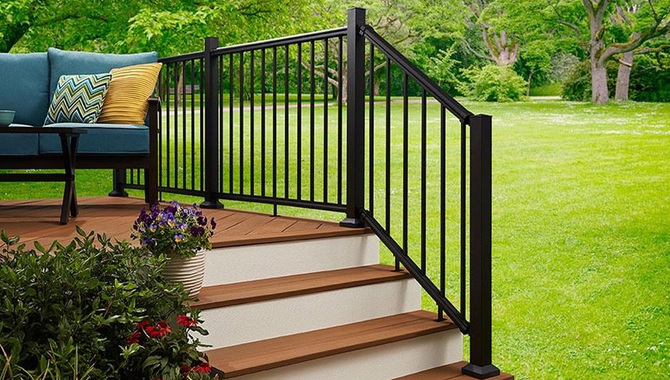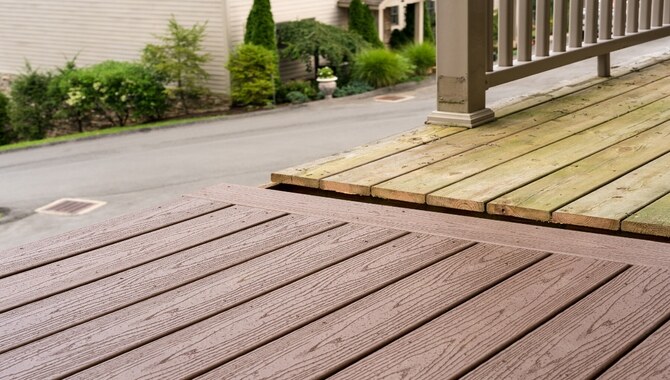Nothing is more relaxing than spending a beautiful evening with your family and friends on a deck. Building a deck can be an exciting project if you want to host a BBQ, relax with your loved ones, or simply enjoy the view. However, it can also be overwhelming if you don’t know where to start.
Here we provide pro tips on how to build a deck, from planning your project to installing decking boards with precision. We also cover the essential tools and materials you’ll need and how to choose the right railing for your deck. With these expert tips, building your dream deck has never been easier.

How To Build A Deck With A Few Pro Tips

Proper planning and preparation are necessary when building a deck. Choosing the right materials, like composite decking or pressure-treated lumber, that complement the intended location and use.
Safety comes first, so be sure to follow building codes, and regulations in your area, use safety equipment at all times, and hire professionals for large decks or complex structures.
When constructing a deck frame or designing a substructure with joists, keep joist spacing within range while ensuring the right span, size, width, and depth of the beam.
You can attach beams and posts to anchors with washers or bolt them together using lag bolts with brackets. Ledger boards secure the deck to your house while flashing protects against rot. Here is step by step process on how to build a deck.
1. Planning Your Deck Build

When preparing for deck construction, proper planning is crucial for success. To ensure a solid foundation for your project, consider factors such as the intended purpose of your deck, your yard’s size and shape, applicable building codes and regulations in your local area, and any existing structures or trees that may impact the design.
Additionally, make sure to carefully select materials that fit within both your budget and desired aesthetic. Remember to have all necessary tools and equipment on-hand before beginning construction. Following these tips for planning your deck build, you can create a beautiful outdoor space that will provide years of enjoyment.
2. Essential Tools And Materials You’ll Need

To ensure your deck construction project goes well, you must have all the necessary tools and materials. A DIY enthusiast should have circular saws, drills, and hammers. The materials needed include decking boards made of pressure-treated lumber or hardwoods like cedar which can withstand rot, or composite decking, which lasts long while requiring less maintenance.
Joists are used to frame the deck in place, while concrete footings or pier blocks serve as support bases for them. Always measure twice with a tape measure before making cuts with a circular saw, and don’t forget to wear protective gear when using power tools.
3. Digging Holes For Deck Posts

To create a stable deck, digging holes for deck posts is crucial. The hole’s depth depends on soil conditions and post size, so level each post to ensure proper alignment. Gravel or concrete added at the bottom of each hole stabilizes posts from shifting over time.
Building your own deck requires tools like circular saws, drills, and hammers, alongside materials such as decking boards, joists, screws, and concrete footings. Always measure carefully before starting construction.
Following building codes when constructing your own deck ensures safety with pressure-treated lumber or hardwoods like cedar for framing or composite decking options.
4. Pouring Concrete And Setting Post Anchors

Setting post anchors and pouring concrete are vital to constructing a robust and long-lasting deck. It’s essential to ensure the ground is level and free from any debris or obstructions before pouring concrete. Level each post anchor while setting it up to prevent any future shifting.
For compliance with local building codes, follow all necessary rules during the deck construction process. Consider using pressure-treated lumber for framing and durable decking materials such as composite decking or hardwoods. Don’t forget about safety; install railings and stairs accordingly.
5. Attaching Beams And Posts To

To properly attach beams and posts to anchors when building a deck, it’s essential to select the appropriate anchor size based on the weight requirements and soil conditions. Using galvanized or stainless steel hardware will increase durability while preventing corrosion.
It is important to consult local building codes and regulations in creating a safe deck. When unsure about any aspect of the deck-building process, consider seeking expert advice from a professional carpenter or landscaper.
6. Connecting Rim Joists And Angle Brackets

A safe and secure deck requires proper installation when connecting rim joists to angle brackets. To achieve this, make sure to use the correct hardware and fasteners while measuring and cutting your angle brackets with precision.
Following local building codes and regulations is essential to ensure proper installation. Don’t forget to consult with a professional if you are unsure about any aspect of the deck-building process.
7. Installing Inner Joists Onto Beams

To ensure a stable and secure deck, it’s crucial to properly install the inner joists onto beams. This can be achieved by using appropriate hardware like joist hangers or screws. Remember that the spacing between the joists should be determined based on the material used for decking.
To prevent sagging or collapse, ensure the inner joists are level and firmly attached to the beams. Accurate installation of inner joints is essential for both the safety and longevity of your deck. Other factors like composite decking, pressure-treated lumber, ledger boards, post bases, and more should also be considered when building your own deck.
8. Fastening Deck Boards Onto Joists

When it comes to building a deck, one important aspect is knowing how to fasten your deck boards onto the joists properly. Selecting the right type of fastener is crucial based on the decking material and joist spacing.
Among the options available are screws, nails, or hidden fasteners. While screws and nails provide long-lasting support, they require regular maintenance.
On the other hand, hidden fasteners provide an aesthetically pleasing appearance while reducing tripping or snagging on exposed fasteners. Properly spaced boards can also enhance your deck’s overall look and durability. For best results, be sure to use consistent spacing between each board.
9. Trimming Decking Boards With Precision

Achieving a professional finish for your deck requires precise trimming of decking boards. To do this accurately, take careful measurements and make markings before cutting with the appropriate tool like circular saws, miter saws, or jigsaws.
Remember to take precautions like wearing safety glasses and earplugs while handling power tools. Smooth out any rough edges after cutting with sandpaper or routers. Well-trimmed decking boards provide better fitting and improve your deck’s overall appearance and longevity.
How To Choose The Right Railing For Your Deck

Choosing the perfect railing for your deck involves several factors. It’s essential to think about the design and style of your patio or DIY deck while selecting a railing that complements it perfectly.
Ensure that you pick durable materials like composite decking or pressure – treated lumber that can resist rotting and decay over time with minimal upkeep requirements.
Additionally, check with local building codes to ensure compliance with safety regulations before installing the railing. Don’t forget to factor in costs when deciding on railings for multi-level decks or hot tubs.
Composite Decking Vs Wood: Which Is Better?

When it comes to decking materials, the age-old question remains: composite or wood? While both materials have their pros and cons, there are some key differences to consider when making your decision.
Composite decking is made from a combination of wood fibers and recycled plastic, resulting in a durable and low-maintenance option. It is resistant to rot, mold, and insects, making it ideal for outdoor use.
On the other hand, wood decking provides a more natural look and feel, with a wide range of species and finishes to choose from. However, wood requires regular maintenance such as sealing and staining to prevent deterioration over time.
Ultimately, the choice between composite decking and wood will depend on your personal preferences and needs. If you’re looking for a long-lasting and low-maintenance option, composite may be the way to go. But if you prioritize a natural aesthetic and don’t mind the upkeep, traditional wood may be more your style.
Conclusion
A deck is a great way to add outdoor living space and value to your home. However, it can be challenging if you’re unsure where to start. Planning ahead and understanding the tools and materials needed for the job is important. Our expert tips cover everything from digging holes for deck posts to precision fastening deck boards onto joists.
By following the steps outlined in this guide on how to build a deck, you can build a beautiful and functional deck that will last for years to come. Remember to take your time, use high-quality materials, and follow all safety guidelines throughout construction. If you have any questions or need further assistance with building your deck, don’t hesitate to reach out for help from professionals in the field.
Frequently Asked Questions
[rank_math_rich_snippet id=”s-4d37cfd6-a3dd-4522-89e6-0a9b261486d2″]

I am passionate about home engineering. I specialize in designing, installing, and maintaining heating, ventilation, and air conditioning systems. My goal is to help people stay comfortable in their homes all year long.








